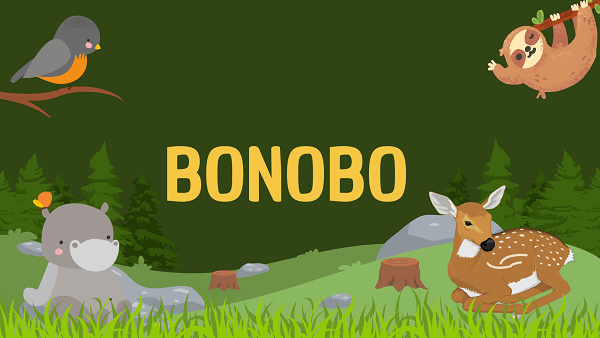Bonobo | Facts, Diet, Habitat & Pictures
Home » Animals » Bonobo | Facts, Diet, Habitat & Pictures
Bonobo Overview
Appearance
Bonobos are close relatives of chimpanzees and exhibit a distinct appearance: With a lean and compact build, they have black faces, long hair, and a hair parting that varies individually. Bonobo stands upright, moving on all four limbs.
Their expressive eyes and facial features convey complex emotions. Their body language, including gestures and vocalizations, and facilitates intricate social interactions within their communities.
Origins And Evolution
The origins and evolution of bonobos are enmeshed in the rich tapestry of great ape history. Diverging from a common ancestor with chimpanzees, they carved a unique path driven by environmental factors and selective pressures.
Inhabitants of the dense rainforests of Central Africa, bonobos adapted traits like their gracile build, arboreal acumen, and peaceful social structure. Their evolutionary journey witnessed the emergence of sophisticated behaviors, including cooperative hunting and problem-solving skills.
Amid the tumultuous landscapes of the past, bonobos’ divergence from chimpanzees underscored the fascinating and intricate process that led to their distinction as a distinct and remarkable species.
Behavior and Lifestyle
Bonobos exhibit a captivating behavior and lifestyle intricately woven with their social dynamics. Renowned for their peaceful and egalitarian social structure, they engage in intricate bonding and cooperation, often resolving conflicts through affiliative interactions and sexual behaviors.
As adept climbers and ground-dwellers, they forage for a diverse diet of fruits, leaves, and occasionally small animals. Communication among bonobos involves vocalizations, facial expressions, and body postures, contributing to their tightly-knit social networks.
Scientific Classification
- Kingdom: Animalia
- Phylum: Chordata
- Class: Mammalia
- Order: Primates
- Suborder: Haplorhini
- Family: Hominidae
- Genus: Pan
- Species: Pan paniscus
Bonobo Locations
- Democratic Republic of Congo (DRC)
- Central Africa
Bonobo Fast Facts
- Name: Bonobo
- Scientific Name: Pan paniscus
- Habitat: Rainforest Canopy
- Diet: Omnivorous Fruits
- Physical Features: Slender Build
- Nocturnal: Partially Nocturnal
- Solitary: Socially Bonded
- Unique Order: Hominidae Family
- Lifespan: 40 Years
- Conservation Status: Endangered Species
- Fun Facts: Intelligent Problem-Solvers
Physical Characteristics
- Color: Black Fur
- Skin Type: Dark Pigmentation
- Top Speed: Agile Climbers
- Lifespan: 40 Years
- Weight: Lightweight Build
- Length: Compact Bodies
- Age of Sexual Maturity: 13 Years
- Age of Weaning: 4-5 Years
Bonobo FAQs
What is a bonobo?
A bonobo (Pan paniscus) is a species of great ape closely related to chimpanzees. They are known for their peaceful and cooperative social behaviors.
How are bonobos different from chimpanzees?
Bonobos and chimpanzees are closely related but have distinct social behaviors. Bonobos are often characterized by their more peaceful and egalitarian society.
What do bonobos eat?
Bonobos have an omnivorous diet that includes fruits, leaves, stems, insects, and occasionally small animals.
Are bonobos endangered?
Yes, bonobos are listed as endangered due to habitat loss, poaching, and other threats.
Related:
- Tarantula
- Mackerel
- Mackerel
- Sea Stars
- Bird
- Amphibians
- Vertebrates
- Sand Dollars
- Barnacles
- Scallop
- Brittle stars
- Tilapia
- Carp
- Krill
- Catfish
- Grouper
- Calm
- Yak
- Yucatan Brown Brocket
- White-tailed Deer
- Uakari
- Utahraptor (Dinosaur)
- Qinghai Lake Naked Carp
- Qilian Shrew
- Qinling Panda
- Qacha’s Nek long-fingered Frog
- Red Fox
- Red Panda
- Rockhopper Penguin
- Salamander
- Snail
- Storks
- Jacana
- Junglefowl
- Jabiru Stork
- Junco
- Japanese Crane
- Kudu
- Kingfisher


